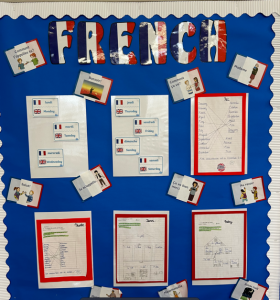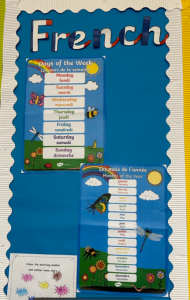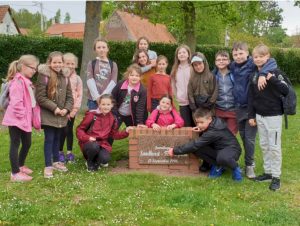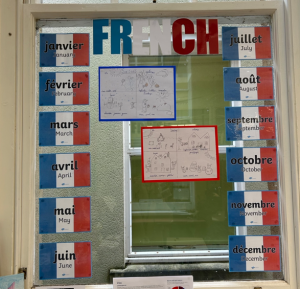
 Lightbulb Languages:Lightbulb Languages is a progressive scheme of work we use here at Sandhurst Primary School in Key Stage 2. Although Lightbulb Languages provides lessons plans and has resources that can be used for every lesson, the framework does not prescribe specific topics or contexts for learning. It gives teachers the freedom to be creative and innovative and to devise programs of work and activities, which will engage, excite and challenge children. Lessons are stimulating, enjoyable and challenging, reflecting children’s increasing maturity as they move through Key Stage 2. We aim to offer inspiration to communicate and use French creatively and in real life situations. The core Learning Objectives for speaking, reading, writing and listening are progressive and are listed in full for each year.
Lightbulb Languages:Lightbulb Languages is a progressive scheme of work we use here at Sandhurst Primary School in Key Stage 2. Although Lightbulb Languages provides lessons plans and has resources that can be used for every lesson, the framework does not prescribe specific topics or contexts for learning. It gives teachers the freedom to be creative and innovative and to devise programs of work and activities, which will engage, excite and challenge children. Lessons are stimulating, enjoyable and challenging, reflecting children’s increasing maturity as they move through Key Stage 2. We aim to offer inspiration to communicate and use French creatively and in real life situations. The core Learning Objectives for speaking, reading, writing and listening are progressive and are listed in full for each year.
At Sandhurst, French is a subject the children enjoy because it is something different in the curriculum. They get lessons delivered once a week by one of our native French teaching assistants who ensures work is completed to a high standard. Children begin to learn French in Year 3 and continue up to Year 6. Lightbulb Languages allows children to learn new topics each year as it is a progressive scheme of work. As children develop the four skills (speaking, listening, reading and writing) they are encouraged to use what they have learnt to speak to the teacher and their peers in French where appropriate. Children’s vocabulary is broadened through rich vocabulary taught during the input of the lesson and is then repeated throughout the lesson for children to absorb and use if they are confident. The French curriculum is well-planned and resourced with a focus on communication as this is key for our children’s futures.
As mentioned previously, Lightbulb Languages provides lesson plans to follow. Each lesson begins with an oral element to ensure pronunciation is correct, gets children engaged ready for their lesson and recaps previous lesson content. The lesson then moves onto the teacher input, where again, the listening and speaking skills are evident. The children will then be given some work which will be reading and writing with some oral activities. To finish the lesson, the teacher will then go over the work and end with some role play or songs.
Incorporating French into Key Stage 2’s weekly timetable is key so children can build up confidence and fluency in a foreign language. Lightbulb Languages ensures children progressively acquire, use and apply a developing bank of knowledge to use in and outside of French lessons. Through careful use of resources and planning, children have a chance to learn all four key skills of foreign languages which lay the foundations for their future.
Possible Career Aspirations for the Future
We want our pupils to develop a love for languages and as a result remind them, if they continue to aim high they could become a Specialist language teacher, Interpreter, Speech therapist across the globe or choose from many other exciting professions!
Oracy – Learning Objectives
| Oracy – Learning Objectives | ||
| Children should be taught to: | Children should, for example: | |
| O3.1 Listen and respond to simple rhymes, stories and songs | Identify rhyming words.
Perform finger rhymes and sing songs. Join in with storytelling. |
|
| O3.2 Recognise and respond to sound patterns and words | Listen with care.
Identify phonemes which are the same as or different from English and other known languages. Speak clearly and confidently. |
|
| O3.3 Perform simple communicative tasks using single words, phrases and short sentences | Recall, retain and use vocabulary. Ask and answer questions. | |
| O3.4 Listen attentively and understand instructions, everyday classroom language and praise words | Repeat words and phrases modelled by the teacher.
Remember a sequence of spoken words. Use physical response, mime and gesture to convey meaning and show understanding. |
|
| O4.1 Memorise and present a short spoken text | Learn finger rhymes, poems or a non-fiction text. Learn and say several sentences on a topic. | |
| O4.2 Listen for specific words and phrases | Listen with care.
Use physical response to show recognition and understanding of specific words and phrases. |
|
| O4.3 Listen for sounds, rhyme and rhythm | Identify specific sounds e.g. rhymes, letters, phonemes, words.
Compare different sounds. |
|
| O4.4 Ask and answer questions on several topics | Practise asking and answering questions with a partner.
Develop and perform simple role plays. |
|
| O5.1 Prepare and practise a simple conversation, re-using familiar vocabulary and structures in new contexts | Focus on correct pronunciation and intonation. Ask and answer questions.
Use tone of voice and gesture to help to convey meaning. |
|
| O5.2 Understand and express simple opinions | Agree and disagree with statements. Understand and express like and dislikes. | |
| O5.3 Listen attentively and understand more complex phrases and sentences | Understand the main points from speech which includes unfamiliar language. | |
| O5.4 Prepare a short presentation on a familiar topic | Recall, retain and use words, phrases and sentences.
Memorise and present a set of instructions, e.g. a recipe, a weather forecast, instructions for making something, a message, an advertisement. |
|
| O6.1 Understand the main points and simple opinions in a spoken story, song or passage | Listen attentively, re-tell and discuss the main ideas.
Agree or disagree with statements made about a spoken passage. |
|
| O6.2 Perform to an audience | Present a short piece of narrative either from memory or by reading aloud from text.
Develop a sketch, role-play or presentation and perform to the class or an assembly. |
|
| O6.3 Understand longer and more complex phrases or sentences | Re-tell using familiar language a sequence of events from a spoken passage, containing complex sentences.
Understand and express reasons. Understand the gist of spoken passages containing complex sentences e.g. descriptions, information, instructions. |
|
| O6.4 Use spoken language confidently to initiate and sustain conversations and to tell stories | Participate in simple conversations on familiar topics.
Describe incidents or tell stories from their own experience, in an audible voice. |
|
Literacy – Overview
| Literacy - Overview | |
| Year 3
As children listen to sounds, words and phrases, they repeat and chorus, learning accurate pronunciation. They then gradually learn to link simple phonemes and spellings. They enjoy reading a few familiar words and phrases aloud and begin to write letters and familiar words. They also experiment with writing some familiar words from memory. |
By the end of Year 3, children should be able to:
|
| Year 4
Children develop their reading skills and learn to understand familiar written phrases in clear printed script. They link listening and reading, by reading short familiar stories, songs and poems while listening to them at the same time. They write familiar words and phrases using a model and begin to experiment with building short phrases from memory. |
By the end of Year 4, children should be able to:
|
| Year 5
Children revisit and consolidate vocabulary and structures learnt previously, and build on this prior learning. They develop their reading skills by re-reading a range of short texts. They learn to put familiar words into sentence order. They continue to develop their writing skills by using words and phrases to build sentences and short texts with support. |
By the end of Year 5, children should be able to:
|
| Year 6
Children read a variety of longer texts from different text types. They read aloud with confidence and enjoyment, and also enjoy reading short texts independently. They learn to write some short, simple sentences from memory and continue to develop their writing skills by constructing short texts using a model. |
By the end of Year 6, children should be able to:
|
Literacy – Learning Objectives
| Literacy – Learning Objectives | ||
| Children should be taught to: | Children should, for example: | |
| L3.1 Recognise some familiar words in written form | Understand words displayed in the classroom identify and read simple words.
read and understand simple messages. |
|
| L3.2 Make links between some phonemes, rhymes and spellings, and read aloud familiar words | Pronounce accurately the most commonly used characters, letters and letter strings.
Read aloud a familiar sentence, rhyme or poem. |
|
| L3.3 Experiment with the writing of simple words | Write simple, familiar words using a model. Write some single words from memory. | |
| L4.1 Read and understand a range of familiar written phrases | Match phrases and short sentences to pictures or themes.
Identify non-fiction texts by their style and layout, e.g. a recipe, a weather forecast, instructions for making or doing something, a letter, an advertisement. |
|
| L4.2 Follow a short familiar text, listening and reading at the same time | Make links between the spoken and written words. Identify common spelling patterns in letter strings. | |
| L4.3 Read some familiar words and phrases aloud and pronounce them accurately | Read aloud words which they use on a regular basis, e.g. numbers, days, weather. | |
| L4.4 Write simple words and phrases using a model and some words from memory | Pronounce letter strings, words and phrases accurately with good pronunciation.
Write labels for work on wall displays and in their books. Complete a semi-completed e-mail message to someone in a partner school. |
|
| L5.1 Re-read frequently a variety of short texts | Read fiction and non-fiction texts, e.g. extracts from stories, e-mail messages and texts from the Internet. | |
| L5.2 Make simple sentences and short texts | Understand that the order of words in a sentence influences the meaning.
Make a sentence using single word cards. Make a short text using word and phrase cards; link to relevant NLS sentence level objectives. |
|
| L5.3 Write words, phrases and short sentences, using a reference | Choose words, phrases and sentences and write them into a gapped text or as picture captions. Use a bilingual dictionary to check the spelling of familiar words. | |
| L6.1 Read and understand the main points and some detail from a short written passage | Read and respond to e.g. an extract from a story, an e-mail message or song.
Give true or false responses to statements about a written passage. Read descriptions of people in the school or class and identify who they are. |
|
| L6.2 Identify different text types and read short, authentic texts for enjoyment or information | Read for enjoyment an e-mail message, short story or simple text from the Internet.
Read and understand the gist of a familiar news story or simple magazine article. |
|
| L6.3 Match sound to sentences and paragraphs | Use punctuation to make a sentence make sense. Listen carefully to a model, e.g. a video recording, recorded story or song, and re-constitute a sentence or paragraph using text cards.
Apply most words correctly. |
|
| L6.4 Write sentences on a range of topics using a model | Construct a short text, e.g. create a PowerPoint presentation to tell a story or give a description. | |
Intercultural Understanding – An Overview
| Intercultural Understanding – An Overview | |
| Year 3
Learning a language arouses children’s interest and curiosity in their own identities and helps them to see the relationships between their lives and those of others. During the year they think about the linguistic diversity of their own school and talk about the languages they would like to learn. They find out where the language they are learning is spoken. They make contact either in person or through Internet or video with a partner school or native speaker, e.g. a parent, or a language assistant. |
By the end of Year 3, children should be able to:
|
| Year 4
Children reflect upon celebrations in which they participate at home, at school and in the wider community, and discuss the similarities with celebrations in other cultures. They compare aspects of everyday life at home and abroad, e.g. sports and hobbies, with children from other countries. They identify common elements in traditional stories from other cultures. |
By the end of Year 4, children should be able to:
|
| Year 5
Children discuss aspects of daily life which they have in common with children in different countries. They look at the similarities and differences between their own locality and that of another country. Children also learn about symbols, objects and products that represent countries. |
By the end of Year 5, children should be able to:
|
| Year 6
Children compare attitudes of different cultures. They discuss stereotypes and reflect on the importance of developing tolerance and understanding between people. They celebrate their understanding and knowledge with others. |
By the end of Year 6, children should be able to:
|
Intercultural Understanding – Learning Objectives
| Intercultural Understanding – Learning Objectives | |
| Children should be taught to: | Children should, for example: |
| IU3.1 Learn about the different languages spoken by children in the school | Increase awareness of linguistic and cultural diversity. |
| IU3.2 Locate country/countries where the language is spoken | Identify some of the countries where the language is spoken, drawing on the knowledge of class members where appropriate.
Know some facts about one country, e.g. climate, main towns, famous landmarks, produce. |
| IU3.3 Identify social conventions at home and in other cultures | Learn about polite forms of address. Know how to greet native speakers. Recognise some typical names. |
| IU3.4 Make indirect or direct contact with the country/countries where the language is spoken | Have contact with a native speaker, including peers where appropriate.
View a video or media resource about the country. Send an e-mail, letter or postcard to a partner school. |
| IU4.1 Learn about festivals and celebrations in different cultures | Learn how children of different cultures celebrate special days.
Identify similarities and differences. Learn simple phrases to celebrate festivals, drawing on the experience of pupils where possible. |
| IU4.2 Know about some aspects of everyday life and compare them to their own | Compare pastimes of children of different cultures and countries.
Exchange information with a partner school, e.g. sports, hobbies. |
| IU4.3 Compare traditional stories | Compare characteristics of simple stories between cultures.
Look at the writing system of the language. |
| Learn about ways of travelling to the country/countries | Revise the location of country/countries where the language is spoken.
Identify a route from own locality to specified destination, drawing on the direct experience of pupils where available. |
| IU5.1 Look at further aspects of their everyday lives from the perspective of someone from another country | Consider aspects of everyday life of children in their own and different countries.
Reflect on cultural issues using empathy and imagination to understand other people’s experiences. |
| IU5.2 Recognise similarities and differences between places | Identify geographical features of a contrasting locality.
Learn about buildings and places in different countries. |
| IU5.3 Compare symbols, objects or products which represent their own culture with those of another country | Learn about symbols representing their own country, culture and community. Learn about symbols and products from another country and culture. |
| IU6.1 Compare attitudes towards aspects of everyday life | Recognise similarities and differences in attitudes amongst children in different cultures.
Learn about role models for children in different cultures. |
| IU6.2 Recognise and understand some of the differences between people | Discuss similarities and differences between the cultures they have learned about.
Recognise and challenge stereotypes. |
| IU6.3 Present information about an aspect of culture | Perform songs, plays, dances.
Use ICT to present information, having a greater sense of audience. |
Knowledge about Language (KAL)
| Knowledge about Language (KAL) | |
| Overview of years 3-6 | |
| When learning a new language, children reinforce and reinterpret knowledge and understanding gained in learning their first language(s).
In the early years children should develop insights into the sounds and some of the structures of the new language and compare them with their own language(s). As they increase their understanding of the rules of sounds, spellings and grammar, they should begin to apply these rules when creating new language, both spoken and written. As they progress, children should have frequent opportunities to apply previously learnt knowledge and rules in English and the new language. Children will have experience of learning about and using simple grammatical terms such as nouns, verbs, adjectives, adverbs and pronouns. They will need to apply this knowledge in the context of learning about languages which are new to them. This knowledge can be taught in the new language or in English. |
Children should have opportunities to:
|
Knowledge about Language (KAL) - Summary Objectives
| Knowledge about Language (KAL) – Summary Objectives |
| The objectives for developing children’s Knowledge about Language are integrated into the learning objectives and teaching activities for Oracy, Literacy and Intercultural Understanding. It is assumed that these integrated versions will be used for day-to-day planning purposes. In order to further develop learning programmes and assist the monitoring of course content and learners’ progress, examples of the main KAL elements linked to each learning objective are also summarised below. |
| KAL – Year 3 |
O3.1
O3.2
O3.3
O3.4
|
L3.1
L3.2
L3.3
|
IU3.1
IU3.2
IU3.3
IU3.4
|
| KAL – Year 4 |
O4.1
O4.2
O4.3
O4.4
|
L4.1
L4.2
L4.3
L4.4
|
IU4.1
IU4.2
IU4.3
IU4.4
|
| KAL – Year 5 |
O5.1
O5.2
O5.3
|
L5.1
L5.2
L5.3
|
IU5.1
IU5.2
IU5.3
|
| KAL – Year 6 |
O6.1
O6.2
O6.3
O6.4
|
L6.1
L6.2
L6.3
|
IU6.1
IU6.2
IU6.3
|



